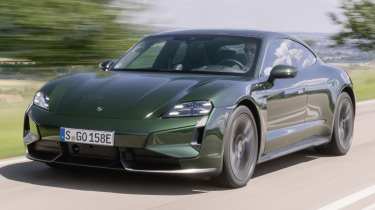Best GT cars 2025 – the ultimate continent crossers
The best GTs combine the opulence and comfort of a luxury saloon with the style, performance and sense of occasion of a supercar – these are evo’s favourites
It’s been a fantastic few years for the most illustrious and long-lived breed of performance cars; the grand tourer. Newcomers from Maserati, Ferrari, Aston Martin, Ferrari and Bentley make up a class that now features powertrains ranging from naturally aspirated, to turbocharged, hybrid and even some that are fully electric. Most are of course front engined, but some are all-wheel drive, some are rear-wheel drive and some don’t even limit the door count to two.
No matter how they go about achieving it, the best grand tourers must nail the same brief – to consume miles in ease and comfort but still engage when the road, and the moment, allows. The best GTs combine the typical luxury car attributes with the sense of drama and occasion usually reserved for supercars. These are our favourite current GT cars, from an 800bhp V12 Ferrari to an all-electric four-door Audi.
Best GT cars 2025
- Bentley Continental GT Speed
- Ferrari 12 Cilindri
- Aston Martin Vanquish
- Mercedes-AMG GT
- Porsche Panamera
- Porsche Taycan
- Audi e-tron GT
- Maserati GranTurismo
Bentley Continental GT Speed
Priced from £236,605
Pros – New hybrid powertrain suits the GT’s character nicely...
Cons – ...but makes an already heavy car heavier still
The new Bentley Continental GT’s job is to make the demise of the W12 engine a little less sore. It was an engine we all grew to love, that came to define the marque in the 21st century, but now it’s no more. Happily, the new GT Speed’s V8 hybrid powertrain suits the character of the Continental GT down to the ground, bringing a new kind of versatility that fits the flying B very well indeed. Pair that with a chassis that’s more playful, more willing, and you get the most sporting Bentley yet made – and perhaps the best Continental GT yet. By definition, that makes this one of the best GT cars, certainly on the more luxurious side of things, available right now.
‘It feels enormous – bordering on too large to feel suitable for UK roads – but it handles like a car far smaller than it really is. Far lighter, too: this is a 2.4-ton car, but it’s only when you get it moving around that you realise just how much momentum is at play.’ – James Taylor, evo Deputy Editor, who drove the Continental GT Speed on the launch and in the UK.
Alternatives to the Bentley Continental GT Speed
There isn’t much that blends performance, luxury and exquisite build quality quite like the Continental GT. Aston Martin’s DB12 isn’t as cosseting, while the Maserati GranTurismo isn't as opulent inside. With that said, the Bentley isn’t at the top of the list when it comes to outright thrills – both the Aston and Maserati are more dynamic to drive.
Ferrari 12 Cilindri
Priced from £336,500
Pros – Outright pace, predictability, GT credentials
Cons – Interior ergonomics, visibility, price
Ever since the Ferrari 599 crept beyond the 600bhp mark with a mildly detuned engine from the Enzo, there’s been a sense the front-engined, two-seat V12 Ferrari has become more of a supercar than a GT. That was only compounded by the howling Ferrari F12 and incredibly intense Ferrari 812. Well, for those who miss the 550 glory days, the 12 Cilindri might be for you, because this is a calmer, more settled Ferrari V12 with a longer fuse. It’s still a 6.5-litre V12, 819bhp monster that’ll hit 62mph in 2.9sec on the way to a 211mph+ top speed but when not calling upon that potency, this car can dull itself quite unlike its immediate predecessors. Does that mean it’s missing the bite and ultimate excitement of the 812 and F12? Perhaps, but it also makes the 12 Cilindri an accomplished, more rounded and still deeply desirable GT.
‘A good part of the 12 Cilindri’s bandwidth is still focused on being a thrilling driver’s car as well as a GT. It responds like a lightweight mid-engined sports car rather than a large front-mid-engined GT car. You revel in the swiftness with which it responds as one, with zero slack.’ – James Taylor, evo Deputy Editor, who drove the 12 Cilindri on the launch.
Alternatives to the Ferrari 12 Cilindri
The 12 Cilindri’s closest rival is another V12, 800bhp+, £300k+ super GT – the Aston Martin Vanquish. The two might appear similar on paper but they have starkly different characters, the Vanquish trading the 12 Cilindri’s screaming N/A V12 for a gutsy twin-turbo unit that arguably sounds even better. Both are available as convertibles too, giving you closer access to their sensational engines.
Aston Martin Vanquish
Priced from £350,000
Pros – Looks; sound; performance; handling
Cons – Some road noise; not much space; HMI
Aston Martin is on a bit of a roll at the moment with a superb line up of sports GTs, and the Vanquish is the best of the bunch. It has all the presence and glamour you’d expect of a flagship Aston, and a compelling combination of brutality and finesse that’s enough to give Ferrari’s 12 Cilindri a headache. Huge performance from its 824bhp twin-turbo 5.2-litre V12, a rewarding chassis and a sumptuous cabin that’s a world away from the old DBS Superleggera ensure it has every basis covered as a GT – it’s not just the best current Aston, it’s up there with the best models of all time.
‘The scale of performance in the Vanquish is epic, monumental. Find a decent straight, nail it and hear the V12 roar as it accelerates with such solid determination that it feels like it’s going to keep piling on the speed at an unabated rate until you run out of nerve, or road, or hit 214mph.’ – John Barker, evo editor-at-large, who drove the Vanquish on the launch.
Alternatives to the Aston Martin Vanquish
If you want a GT with the kind of performance, involvement and wow factor of the Vanquish, there’s only one other place to look – the Ferrari 12 Cilindri. We haven’t driven them back to back yet, but the signs are that it’ll be a close run battle with the Ferrari being more mellow and rounded than its predecessors while still packing a sensational V12, and the Aston taking a leap forward in dynamics and aggression compared to the DBS Superlegerra that preceded it. We can’t wait to get them together.
Mercedes-AMG GT
Priced from £105,435
Pros – A secure, sure-footed and crushingly effective coupe
Cons – Expensive; still more remote than a 911
The disappointing Mercedes-AMG SL didn't exactly fill us with hope as a precursor to the closely related second-gen AMG GT. But we need not have worried – the AMG GT is a different animal. Despite riding on the same platform and using the same fundamental powertrain, it’s more focused and tightly defined as a usable everyday sports car, and a genuine Porsche 911 rival. The V8 models hit very hard indeed (especially the ballistic 805bhp E Performance hybrid), but the AMG GT has always been quick. Rather, it's the extra sharpness and composure of the new model that really moves the game on – despite it being more usable than ever.
‘At anything less than 100mph the kick is savage, the electrical well delivering first, eliminating what little turbo lag the twin-turbocharged V8 has, and then the two pair up to deliver a double whammy. Your unsuspecting passenger’s head will impact the headrest and stay there for as long as you keep the throttle pinned.’ – John Barker, evo editor-at-large, who drove the GT63 E Performance on the launch.
Alternatives to the Mercedes-AMG GT
At the £142k asking price of the cheapest V8 AMG GT, you can bag a Maserati GranTurismo – a more practical two-door coupe with a more special design, but lacking the AMG’s composure when covering ground quickly. A closer match in philosophy is the Aston Martin Vantage, which also has an AMG V8 but a more boisterous character, and a much more appealing cabin. At £165,000 it’s positioned squarely against the 577bhp GT63 model.
Porsche Panamera GTS
Priced from £131,700
Pros – A fast, satisfying and usable supersaloon
Cons – Needs more power and aggression to take on the M5; expensive
While Porsche doesn’t strictly offer a traditional two-door grand tourer in its range (the last being the 928), the Panamera has been doing an excellent job of filling that role with its two extra doors over two generations now. The current model was developed on a platform shared with the Continental GT, and packs some serious chassis hardware as a result. On the latter note, a recent facelift has added Porsche’s sophisticated Active Ride suspension that stabilises the platform and cushions the driving experience. This is supported by a rumbly 493bhp V8 in the GTS. It doesn’t have the firepower of hybrid rivals like the new M5, but without a battery to haul around it’s a satisfying, nuanced car to drive. The GTS has all the appeal of a genuine sports saloon, and makes a fine grand tourer.
‘With a neater style, you start to appreciate the subtleties in the way the GTS drives, and how effective it can be from point to point. It stays composed and keyed in under high braking and cornering forces (particularly in the Sport damper setting – Sport Plus is too tense for the road), and breakaway at both axles is progressive and easy to read. It always feels like a big, substantial car, but the clean and accurate steering response means you can pick precise lines and build confidence for corner after corner.’ – Yousuf Ashraf, evo senior staff writer, who drove the Panamera GTS on the launch,
Alternatives to the Porsche Panamera GTS
For less money than the Panamera GTS, you can bag the new, hybrid BMW M5 – it may be heavier and less entertaining than previous models, but it’s still a formidable daily supersaloon, and substantially more powerful than the Panamera. Audi’s RS7 is no longer on sale, leaving the Mercedes-AMG GT 4-door as the Porsche’s other major rival; albeit one costing £159,300. Still, it gets a thumping 630bhp V8 and composed, highly configurable dynamics to sweeten the deal.
Porsche Taycan
Priced from £88,200
Pros – Exceptional performance, range and dynamic ability
Cons – Comes at a hefty price; not as roomy as it should be; inconsistent brake feel
The most remarkable thing about the Taycan is that beyond just being fast and capable, it also drives with the same finesse and attention to detail that defines all Porsches, despite weighing well in excess of two tons. This is felt through the steering, chassis balance and impressive damping, which help to disguise its mass like few rivals can. In 2024 the Taycan was updated with revised styling, more performance, a boost in range and the option of a clever new active suspension system. The standard rear-driven base car can do up to a hefty 421 miles, and range for previously ‘thirsty’ Turbo and Turbo S models has risen to 391 miles. Although you’ll still be at the mercy of the public charging network on a grand tour, these figures are near the top of the electric sports saloon class right now.
‘You’ll recognise the crisp, linear steering response from Porsche sports cars, and the way the Active Ride system counteracts pitch and roll is uncanny. In a car this heavy you’d normally need to slow down your inputs to allow the mass to settle, but not so in the GT. Turn in on the brakes and you can feel the car working all four contact patches rather than leaning heavily on the front axle, and the body stays almost completely flat during hard braking and throttle inputs.’ – Yousuf Ashraf, evo senior staff writer, who drove the Taycan Turbo GT on the launch.
Alternatives to the Porsche Taycan
The Taycan’s closest competitor comes from elsewhere in the Volkswagen Group. Audi’s e-tron GT packs the same platform and tech, including optional active suspension, in a different body and with a different range of powertrain options and prices. It’s not as crisp to drive as the Porsche but it’s still extremely competent, and relaxed over long distances. Another EV saloon worth considering is the Lotus Emeya, which delivers a fluid, satisfying drive in S spec and a space age interior.
Audi e-tron GT
Priced from £108,775
Pros – A comfortable, satisfying and impossibly fast electric GT
Cons – Expensive in base form; inconsistent brake feel
The Audi e-tron GT was updated in 2024 in line with its Taycan sister. Arguably more handsome, the e-tron GT has always had huge appeal by that virtue alone. But that continues on the inside, with an interior that’s less of a pixel fest with more physical buttons. Okay, yes, the new one has haptic steering wheel buttons that are easily grazed but it still gets points for having physical climate controls. To drive, the Audi takes a more languid approach to its dynamics than the Taycan, even though it shares the same sophisticated hydraulically-controlled active damper tech. Over long distances – the longer of which it’s now much more up to thanks to a bigger 97kWh battery and 375-mile range – the Audi generally impresses. While it lacks the ultimate dynamic sparkle of the Taycan, it’s one of the most relaxing EVs to cover ground in.
‘The suspension and steering hardware (including a new quicker rack and rear-wheel steering) are shared with the latest Taycan, but unique software tuning gives it a different feel and character. The e-tron is a fast, accurate GT car, painless to drive quickly but leaning towards being a calm cruiser, where the Porsche can feel more tense and communicative as you ramp up the driving modes.’ – Yousuf Ashraf, evo senior staff writer, who drove the e-tron GT on the launch.
Alternatives to the Audi e-tron GT
The Taycan is the obvious rival to the e-tron GT, but it's a different flavour of the same theme. For something more unique and still hugely capable, there’s the Lotus Emeya. It might weigh as much as three-and-a-half Elises, but there’s fluidity and finesse to the way the Emeya drives, and its cabin looks and feels more special than the Audi’s.
Maserati GranTurismo Trofeo
Priced from £163,470
Pros – Gorgeous looks; stunning performance; capable chassis
Cons – Feels its weight; needs space to come alive; braking performance
The clue's in the name. The Maserati GranTurismo taps into the firm's legacy as a maker of achingly gorgeous, fast and engaging GT cars, picking up where the MC20 left off as one of the finest models of its type. In its final years, the last-gen GranTurismo withered against more advanced and more capable rivals from Aston Martin and Bentley, but from a purely visual standpoint, it remained hard to beat. Thankfully, the new GranTurismo carries forward much of its design DNA, but beneath the skin is a car transformed. The top-spec Trofeo version generates 542bhp from its MC20-derived twin-turbo V6, hurling from 0-62mph in 3.5sec and on to a 199mph top speed. But even when you aren't exercising the engine to test those claims, the GranTurismo feels well engineered and indulgent. It’s not as sharp as an Aston DB12, but its more languid character suits the GT role to a tee.
‘As in the MC20 the Nettuno feels like it’s punching well above its quoted power, piling on the revs with a violent surge akin to a flyweight hot hatch. In a blink it’s gone from a car you want to drive across a country in at a leisurely gate to one that you want to use to devour every twist and turn of your favourite road. The harder you push the more composure there is, the harder the gears hit home the more adjustable the throttle becomes.’ – David Vivian, evo contributor, who drove the GranTurismo on the road in the UK.
Alternatives to the Maserati GranTurismo
The GranTurismo sits somewhere between the ultra-luxurious, heavyweight Bentley Continental GT Speed and the harder, more dynamic Aston Martin DB12. The three are different enough in character that there’s room for all of them and taste could dictate your choice, although the Maserati is kindest on your wallet – the DB12 is £22k more, and the Bentley has jumped up to over £236k in its latest Speed guide, though a lower-spec has arrived to fill the gap.











